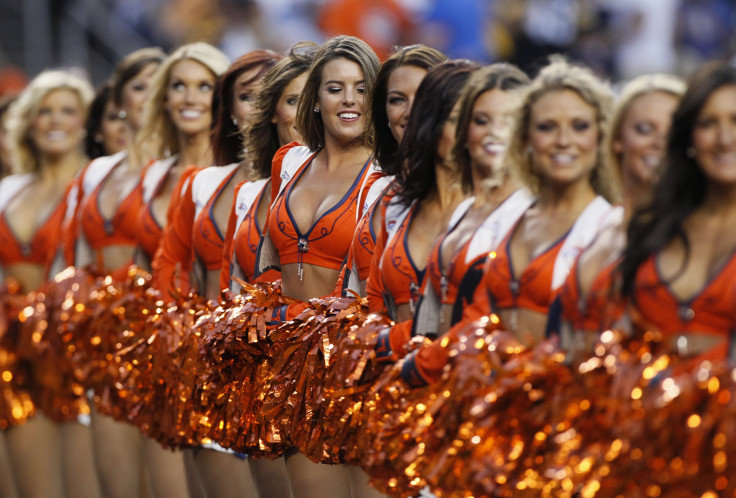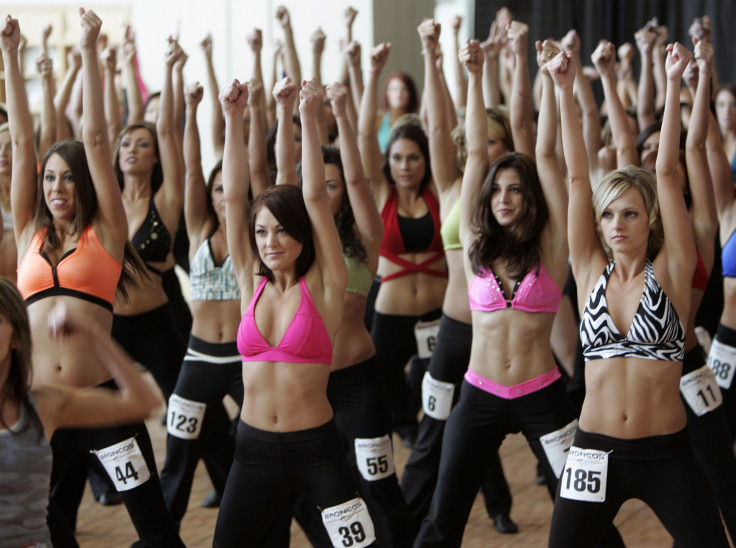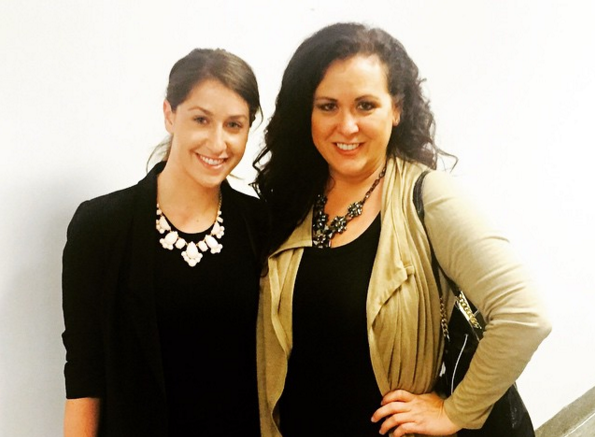NFL Cheerleader Pay: Ongoing Fight For Minimum Wage Underscores Inequality During Super Bowl 2016

For football players, the goalpost is always in clear sight, but for those on the sidelines cheering them, the goal of getting paid a decent wage can feel a lot further away than 120 yards.
It’s been two years since an NFL cheerleader named “Lacy T.” filed a wage-theft lawsuit against the Oakland Raiders claiming she was paid less than $5 an hour after mandatory appearances at events and rehearsals were factored in. The lawsuit touched off a megaphone-level debate about fair pay, workplace exploitation and the treatment of women in professional sports, sparking a litigious chain reaction that reached far and wide throughout the world’s richest sports league.
In the months that followed, lawsuits were filed against NFL clubs such as the Buffalo Bills, Cincinnati Bengals, New York Jets and Tampa Bay Buccaneers. Tired of exhaustive workouts and performing acrobatic dance routines for a pittance, NFL cheerleaders sought back wages and benefits. And many said it was about time.
“Any organization is going to take advantage of you and exploit you until you’ve had enough,” said Lisa Murray, a former NBA dancer who cheered professionally with Lacy T. on the Golden State Warriors and has since gone on to be one of the most vocal advocates of fair cheerleader pay. “You have to know your rights and fight for them.”
But two years into that fight, Murray and others on the front line concede that not much has changed, both in the battle to improve working conditions and, more crucially, in the broader effort to change the culture within the NFL. Four of the cheerleader lawsuits were settled, with teams agreeing to pay out more than $2.5 million combined in back wages. But they admitted no wrongdoing. What’s more, those teams that have fallen in line do not appear interested in going beyond what is legally required of them. For instance, the Raiders in 2014 began paying cheerleaders $9 an hour, then California’s minimum wage. Any hope that NFL cheerleaders would see wages that better reflect their contribution to the $9 billion colossus that is professional football have been dashed, at least for now.
“It’s moving in the right direction, but it’s just moving slow,” said Diane Todd, the mother of a high-school cheerleader in Santa Monica, California, whose two-year-old petition calling on the NFL to pay cheerleaders a living wage has attracted more than 156,000 signatures.
The ongoing debate over cheerleader pay will no doubt bubble into the mass consciousness again Sunday when the Denver Broncos face the Carolina Panthers in Super Bowl 50. That the game will take place just outside San Francisco — a city infamous for its cavernous wage gap — is weirdly fitting. Broncos quarterback Peyton Manning reportedly earned $2 million just for making it into the Super Bowl, and he will double that amount in the event the Broncos win. And all the players during the game can expect hefty bonuses: $51,000 for each player on the losing team and $102,000 for the victors, as ESPN reported.
Representatives of the Broncos and the Panthers did not respond to multiple requests for comment on what their cheerleaders will be paid, but it’s safe to say it will be on the lower end of the scale. Pay for NFL cheerleaders still hovers around minimum wage at best, and sometimes lower (lawsuits pegged the rate at about $100 to $150 a game). Meanwhile, Murray said cheerleaders are typically not paid bonuses for working the big game.
“They tell the woman they should feel ‘lucky’ to go to the game and have all expenses paid, so no one questions the system,” she said.
In response to criticism of cheerleader wages, NFL teams tend to emphasize that cheerleading is a part-time gig and that most cheerleaders either are full-time college students or have primary jobs outside the squad. Cheerleaders themselves enthusiastically and frequently admit that they do it out of the sheer love of football. “Nobody expects to make a living doing this,” Lacy T. told International Business Times in an interview last year.
And, of course, NFL teams are quick to point out that cheerleading is fun, and that women who are lucky enough to be chosen out of the thousands of hopefuls who audition each season are given an unrivaled platform to perform in front of millions of fans. Exposure, as the story goes, is its own reward.
It’s a sales pitch we hear often from the gatekeepers of glamor industries, and it’s one that sends Murray through the roof. “I have a million things to say about that,” she said. “If you look at any profession and say, ‘Well, you’re going to have fun and make a lot of friends, so you should accept no money,’ it’s the most outrageous thing. The harsh reality is that, for the community of women hired for this, it’s just one big cycle of brainwashing.”

This is not to say there has been no progress. Todd in Santa Monica noted that in the two years since she launched her petition, awareness of the issue has increased dramatically, and pressure applied by lawmakers is helping the cause. She cited a September letter from 19 legislators, spanning eight states, asking NFL Commissioner Roger Goodell to persuade teams to pay cheerleaders minimum wage and give them other employee benefits. “Public pressure is the only thing that’s going to change this,” Todd said.
When asked about the issue, the league has traditionally replied by passing the buck, saying cheerleader pay policies are the responsibility of the individual teams, not the league. But that stance rings hollow to cheerleader advocates who say the NFL, as the trade association for professional football, can and does wield considerable influence over team conduct and policies.
More recently, there are signs that NFL is at least paying attention. Joanna Hunter, a league representative, told IBT in an email Thursday the organization “strongly believes” that all cheerleaders should receive fair wages for their work, although she did not specify what the league considers fair. She also said the NFL is working with “all clubs who have squads to support and promote cheerleaders consistent with this goal.”
Murray, who has been active in the movement since Lacy T.’s lawsuit, has also helped achieve some of its most concrete victories. Last year, she spoke out in support of a proposed California labor law that would grant employee protections and benefits to cheerleaders with the NFL and other professional sports leagues. The measure was introduced by California Assemblywoman Lorena Gonzalez of San Diego — a former cheerleader herself — and signed into law by Gov. Jerry Brown in July.

On the other side of the country, a similar bill is working its way through the state Legislature in New York. That legislation followed a 2014 wage-theft lawsuit against the Buffalo Bills in which former members of the team’s cheer squad, the Jills, claimed they were not paid minimum wage. The team’s response to the lawsuit was to suspend operations of the Jills, but it may be too little too late. Last month, a judge approved class certification for the case, meaning the lawsuit could include as many as 40 cheerleaders per season over a six-season period. The Bills have told media outlets they plan to fight the ruling.
The Jills were classified as independent contractors, which is a common arrangement in the NFL, and one that critics say is a way for teams to shirk the responsibility of providing workplace protections. Christopher Marlborough, the lead attorney on the lawsuit against Bills, said a litany of employee-like requirements were imposed on the cheerleaders, including limiting their ability to fraternize with others and seek outside employment. He said cheerleaders’ social media posts were monitored as well. The Bills have disclaimed responsibility, as the rules were presented to the Jills through management companies.
“There’s no circumstance where they would pass any smell test for independent contractor whatsoever,” Marlborough said. “The amount of control that was exerted over them was extraordinary, even for an employer-employee relationship.”
In fact, the Jills were at the forefront of the cheerleader wage fight. The cheer squad voted to unionize back in 1995, a first for professional football. But the effort was short-lived, with the union disbanding after pressure applied by a sponsor, as Bloomberg News reported.
Murray said unionization of professional cheerleaders is an idea whose time has come. She said she is in the beginning stages of speaking with people who can help set the process in motion, although she admits it will be “a long road ahead” before cheerleader unions become a reality.
An ideal situation would see a cheerleader union for each professional sports league, she said, similar to how players’ unions operate now. While it may be accepted wisdom that NFL players are paid handsomely for their contributions to the game, that wasn’t always the case. And Murray pointed out that the history of fair-pay victories in professional sports is one of dogged determination, and not taking no for an answer.
“No team is ever going to come out and say, ‘Yes, I’ll pay you more money because it’s the right thing to do,” she said. “You’re going to have to fight until the bitter end to get every cent possible.”
This article has been updated with additional information from Marlborough to clarify that the rules imposed on the Jills were presented through management companies.
Christopher Zara covers media and culture. News tips? Email me. Follow me on Twitter @christopherzara.
© Copyright IBTimes 2024. All rights reserved.






















